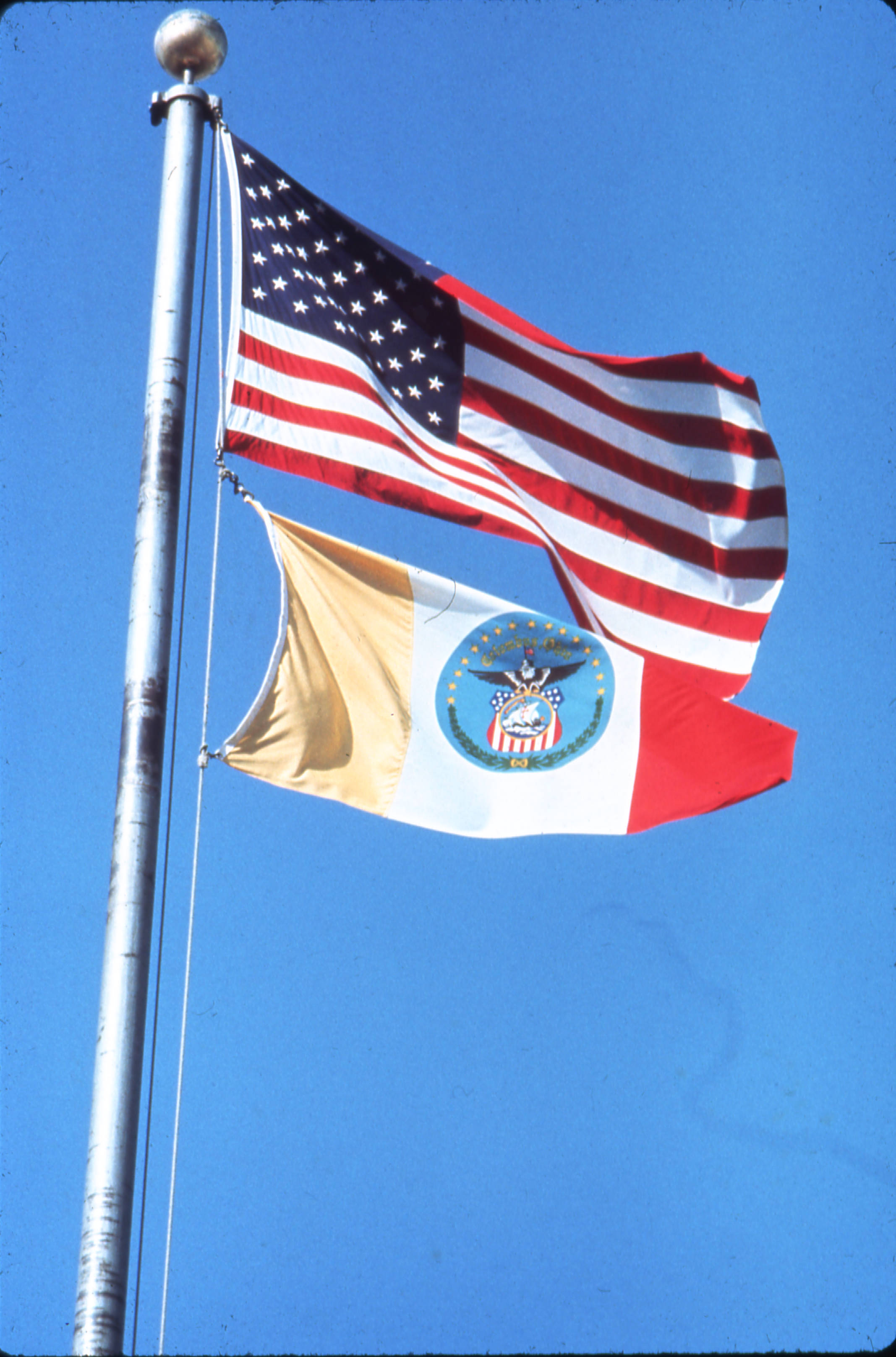|
Flag Of Columbus, Ohio
The flag of Columbus is the official municipal flag of Columbus, Ohio. Its current design is a yellow, white, red vertical triband with the city seal on a blue field. Officially, the flag was adopted in 1929, although it is unknown if the flag was ever flown when it was first adopted. The city's first flag was adopted in 1912. The design consisted of the seal on a blue field. The second and current flag replaced this flag in 1929, but an unofficial flag similar to the one officially defined in legislation rose to higher prominence. Instead of a yellow, white, and red tricolor, it had a red, white, and blue tricolor. It remains unknown how this flag came to be, but after this anomaly was discovered, the city began flying the correct flag. A redesign of the flag began in 2020. During the George Floyd protests, city mayor Andrew Ginther requested changes to the flag to due to its use of imagery related to Christopher Columbus. Design and symbolism The chrome yellow, white, and s ... [...More Info...] [...Related Items...] OR: [Wikipedia] [Google] [Baidu] |
Columbus, Ohio
Columbus () is the state capital and the most populous city in the U.S. state of Ohio. With a 2020 census population of 905,748, it is the 14th-most populous city in the U.S., the second-most populous city in the Midwest, after Chicago, and the third-most populous state capital. Columbus is the county seat of Franklin County; it also extends into Delaware and Fairfield counties. It is the core city of the Columbus metropolitan area, which encompasses 10 counties in central Ohio. The metropolitan area had a population of 2,138,926 in 2020, making it the largest entirely in Ohio and 32nd-largest in the U.S. Columbus originated as numerous Native American settlements on the banks of the Scioto River. Franklinton, now a city neighborhood, was the first European settlement, laid out in 1797. The city was founded in 1812 at the confluence of the Scioto and Olentangy rivers, and laid out to become the state capital. The city was named for Italian explorer Christopher Colum ... [...More Info...] [...Related Items...] OR: [Wikipedia] [Google] [Baidu] |
Eagle
Eagle is the common name for many large birds of prey of the family Accipitridae. Eagles belong to several groups of genera, some of which are closely related. Most of the 68 species of eagle are from Eurasia and Africa. Outside this area, just 14 species can be found—2 in North America, 9 in Central and South America, and 3 in Australia. Eagles are not a natural group but denote essentially any kind of bird of prey large enough to hunt sizeable (about 50 cm long or more overall) vertebrates. Description Eagles are large, powerfully-built birds of prey, with heavy heads and beaks. Even the smallest eagles, such as the booted eagle (''Aquila pennata''), which is comparable in size to a common buzzard (''Buteo buteo'') or red-tailed hawk (''B. jamaicensis''), have relatively longer and more evenly broad wings, and more direct, faster flight – despite the reduced size of aerodynamic feathers. Most eagles are larger than any other raptors apart from some vultures. The ... [...More Info...] [...Related Items...] OR: [Wikipedia] [Google] [Baidu] |
Flag Of Columbus, Ohio (1912–1929)
The flag of Columbus is the official municipal flag of Columbus, Ohio. Its current design is a yellow, white, red vertical triband with the city seal on a blue field. Officially, the flag was adopted in 1929, although it is unknown if the flag was ever flown when it was first adopted. The city's first flag was adopted in 1912. The design consisted of the seal on a blue field. The second and current flag replaced this flag in 1929, but an unofficial flag similar to the one officially defined in legislation rose to higher prominence. Instead of a yellow, white, and red tricolor, it had a red, white, and blue tricolor. It remains unknown how this flag came to be, but after this anomaly was discovered, the city began flying the correct flag. A redesign of the flag began in 2020. During the George Floyd protests, city mayor Andrew Ginther requested changes to the flag to due to its use of imagery related to Christopher Columbus. Design and symbolism The chrome yellow, white, and ... [...More Info...] [...Related Items...] OR: [Wikipedia] [Google] [Baidu] |
WOSU-FM
WOSU-FM (89.7 FM) is a non-commercial educational radio station licensed to Columbus, Ohio, featuring a public radio news and information format known as "89.7fm NPR News". Owned by The Ohio State University, the station serves the Columbus metro area and has multiple repeaters throughout Ohio, making the station a multiple transmitter station. WOSU-FM has an effective radiated power (ERP) of 40,000 watts. Its transmitter is on West Dodridge Road in Columbus, near the Olentangy River. History Classical Music WOSU-FM signed on for the first time on December 13, 1949. It initially simulcast its sister station, WOSU 820 AM, from sign-on until just after sunset, when the AM station, a daytimer, had to go off the air. WOSU-FM then broadcast its own programming until signing off at 7:30 pm. In 1950, the broadcast day was extended to 9:15 pm. It began 24-hour operation in 1960, and began airing a fully separate schedule on October 1, 1968. The station broadcast an all- class ... [...More Info...] [...Related Items...] OR: [Wikipedia] [Google] [Baidu] |
Wíčazo Ša Review
The ''Wíčazo Ša Review'' ("Red Pencil" in Lakota) is a biannual peer-reviewed academic journal of Native American studies. The journal was established in 1985 by editors-in-chief Elizabeth Cook-Lynn (Dakota Santee), Dr. Beatrice Medicine (Lakota), Roger Buffalohead (Ponca), and Dr. William Willard (Cherokee). ''Wíčazo Ša Review'' is published by the University of Minnesota Press, which acquired it in 1999. Originally, it was published at Eastern Washington University, under the guidance of its Native American Studies center. Issues include essays, articles, interviews, reviews, poems, short stories, course outlines, curriculum designs, scholarly research and literary criticism reflective of Native American studies and related fields. The current editor is Dr. Lloyd L. Lee (enrolled Navajo Nation citizen) of the University of New Mexico, who took over the position from James Riding In (Arizona State University Arizona State University (Arizona State or ASU) is a publi ... [...More Info...] [...Related Items...] OR: [Wikipedia] [Google] [Baidu] |
Atlantic Slave Trade
The Atlantic slave trade, transatlantic slave trade, or Euro-American slave trade involved the transportation by slave traders of enslaved African people, mainly to the Americas. The slave trade regularly used the triangular trade route and its Middle Passage, and existed from the 16th to the 19th centuries. The vast majority of those who were transported in the transatlantic slave trade were people from Central and West Africa that had been sold by other West Africans to Western European slave traders,Thornton, p. 112. while others had been captured directly by the slave traders in coastal raids; Europeans gathered and imprisoned the enslaved at forts on the African coast and then brought them to the Americas. Except for the Portuguese, European slave traders generally did not participate in the raids because life expectancy for Europeans in sub-Saharan Africa was less than one year during the period of the slave trade (which was prior to the widespread availability of qu ... [...More Info...] [...Related Items...] OR: [Wikipedia] [Google] [Baidu] |
Artistic Interpretation
In the philosophy of art, an interpretation is an explanation of the meaning of a work of art. An aesthetic interpretation expresses a particular emotional or experiential understanding most often used in reference to a poem or piece of literature, and may also apply to a work of visual art or performance. Aims of interpretation Readers may approach reading a text from different starting points. A student assigned to interpret a poem for class comes at reading differently from someone on the beach reading a novel for escapist pleasure. "Interpretation" implies the conscious task of making sense out of a piece of writing that may not be clear at first glance or that may reward deeper reading even if it at first appears perfectly clear. The beach reader will probably not need to interpret what she or he reads, but the student will. Professor Louise Rosenblatt, a specialist in the study of the reading process, distinguished between two reading ''stances'' that occupy opposite ends ... [...More Info...] [...Related Items...] OR: [Wikipedia] [Google] [Baidu] |
Ohio Secretary Of State
The Secretary of State of Ohio is an elected statewide official in the State of Ohio. The Secretary of state is responsible for overseeing elections in the state; registering business entities (corporations, etc.) and granting them the authority to do business within the state; registering secured transactions; and granting access to public documents. From 1803 to 1851, the Ohio Secretary of State was elected by the Ohio General Assembly to a three-year term. The 1851 Ohio Constitution made the office elective, with a two-year term. In 1954, the office's term was extended to four years. The Secretary of State is elected in even-numbered, off cycle years, (no Presidential elections), after partisan primary elections. List of Ohio secretaries of state See also *Election Results, Ohio Secretary of State *List of company registers This is a list of official business registers around the world. There are many types of official business registers, usually maintained ... [...More Info...] [...Related Items...] OR: [Wikipedia] [Google] [Baidu] |
List Of U
A ''list'' is any set of items in a row. List or lists may also refer to: People * List (surname) Organizations * List College, an undergraduate division of the Jewish Theological Seminary of America * SC Germania List, German rugby union club Other uses * Angle of list, the leaning to either port or starboard of a ship * List (information), an ordered collection of pieces of information ** List (abstract data type) In computer science, a list or sequence is an abstract data type that represents a finite number of ordered values, where the same value may occur more than once. An instance of a list is a computer representation of the mathematical concept of ..., a method to organize data in computer science * List on Sylt, previously called List, the northernmost village in Germany, on the island of Sylt * ''List'', an alternative term for ''roll'' in flight dynamics * To ''list'' a building, etc., in the UK it means to designate it a listed building that may not ... [...More Info...] [...Related Items...] OR: [Wikipedia] [Google] [Baidu] |
Aesculus Glabra
''Aesculus glabra'', commonly known as Ohio buckeye,''Aesculus glabra'' Missouri Botanical Garden is a species of tree in the soapberry family () native to North America. Its natural range is primarily in the and lower Great Plains regions of the United States, extending southeast into the geological Black Belt of ... [...More Info...] [...Related Items...] OR: [Wikipedia] [Google] [Baidu] |
Wreath
A wreath () is an assortment of flowers, leaves, fruits, twigs, or various materials that is constructed to form a circle . In English-speaking countries, wreaths are used typically as household ornaments, most commonly as an Advent and Christmas decoration. They are also used in ceremonial events in many cultures around the globe. They can be worn as a chaplet around the head, or as a garland around the neck. Etymology The word ''wreath'' comes from Middle English ''wrethe'' and from Old English ''writha'' 'band'. History Ancient Etruscan wreaths Wreaths were a design used in ancient times in southern Europe. The most well-known are pieces of Etruscan civilization jewelry, made of gold or other precious metals. Symbols from Greek myths often appear in the designs, embossed in precious metal at the ends of the wreath. Ancient Roman writers referred to Etruscan ''corona sutilis'', which were wreaths with their leaves sewn onto a background. These wreaths rese ... [...More Info...] [...Related Items...] OR: [Wikipedia] [Google] [Baidu] |
Five-pointed Star
A five-pointed star (☆), geometrically an equilateral concave decagon, is a common ideogram in modern culture. Comparatively rare in classical heraldry, it was notably introduced for the flag of the United States in the Flag Act of 1777 and since has become widely used in flags. It has also become a symbol of fame or "stardom" in Western culture, among other uses. History of use Early history The Egyptian hieroglyph representing "star" had five points (N14 N14), while the "star" sign in Mesopotamian cuneiform had eight. Sopdet, the Egyptian personification of the star Sirius, is always shown with the five-pointed star hieroglyph on her head. The star (or '' mullet'') is comparatively rare in medieval heraldry, but from an early time, the five-pointed star was preferred in English and Scottish heraldry (e.g. in the Dering Roll, c. 1270), while the preferred number of points in German heraldry was six. The star in the coat of arms of the De Vere family was in legend a ... [...More Info...] [...Related Items...] OR: [Wikipedia] [Google] [Baidu] |


.gif)

.jpg)


